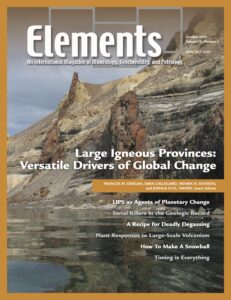Large Igneous Provinces: Versatile Drivers of Global Change
Frances M. Deegan, Sara Callegaro, Henrik H. Svensen, and Joshua H.F.L. Davies – Guest Editors
Table of Contents
Earth’s history is punctuated by volcanic episodes at a scale never witnessed by humans, known as large igneous provinces (LIPs). These extraordinary volcanic and tectonic events are associated with profound changes to planet Earth, including its climate and habitability. One of the major factors controlling the impacts of LIPs is the cocktail of gases emitted to the atmosphere and oceans. In this issue of Elements, we explore the versatile impacts of LIPs, from their connections to mass extinctions in aquatic and terrestrial environments to climate warming and global icehouse events. This issue also highlights our current understanding of subterranean architectures of LIPs, processes and consequences of interaction between LIP magma and surrounding crustal rocks, and advances in the timing of intrusive events.
- Driving Global Change One LIP at a Time
- How Large Volcanic Eruptions Have Killed Most Life on Earth—Numerous Times
- Large Igneous Provinces and the Release of Thermogenic Volatiles from Sedimentary Basins
- Impacts of Large-Scale Magmatism on Land Plant Ecosystems
- The Franklin Large Igneous Province and Initiation of Snowball Earth
- High-Precision Geochronology of LIP Intrusions: Records of Magma–Sediment Interaction
GEOMETALLURGY
Guest Editors: Max Frenzel, Raimon Tolosana-Delgado, and Jens Gutzmer (all of HelmholtzZentrum DresdenRossendorf HZDR, Germany)
Geometallurgy is an interdisciplinary research field concerned with the planning, monitoring, and optimization of mineral resource extraction and processing. Geometallurgy requires a quantitative understanding of primary resource characteristics such as mineralogical composition and texture, the distribution and variability of these characteristics across the target ore body, and how these interact with mining and beneficiation processes. This requires accurate analytical data for resource characterization, a detailed understanding of ore body geology, process technology, economics, and the oftencomplex interactions between them. In this issue of Elements, we explore the fundamental concepts relevant to the field. We also review how current geometallurgical research is opening up opportunities for geoscientists to generate better economic and environmental outcomes for the global raw materials industry as part of a sustainable economy.
- Geometallurgy: Present and Future Max Frenzel (HelmholtzZentrum DresdenRossendorf HZDR, Germany), Regina Baumgartner (Teck Resources Ltd., Canada; Pontifica Universidad Católica del Perú), Raimon TolosanaDelgado (HZDR, Germany), and Jens Gutzmer (HZDR, Germany)
- Characterization of Ore Properties for Geometallurgy Alan R. Butcher (Geological Survey of Finland GTK, Finland), Simon Michaux (GTK, Finland), Quentin Dehaine (GTK, Finland), Andrew H. Menzies (Bruker Nano Analytics, Germany), and Simon P. Michaeux (GTK, Finland)
- All About Particles: Modelling Particle Behaviour in Mineral Processing Lucas Pereira (HelmholtzZentrum DresdenRossendorf HZDR, Germany), Edgar Schach (TU Bergakademie Freiberg, Germany), Raimon TolosanaDelgado (HZDR, Germany), and Max Frenzel (HZDR, Germany)
- Fire and Water: Geometallurgy and Extractive Metallurgy Deshenthree Chetty (MINTEK, South Africa), Glen T. Nwaila (University of the Witwatersrand, South Africa), and Buhle Xakalashe (MINTEK, South Africa)
- Action Versus Reaction: How Geometallurgy Can Improve Mine Waste Management Across the Life-Of-Mine Anita ParbhakarFox (University of Queensland, Australia) and Regina Baumgartner (Teck Resources Ltd., Canada; Pontifica Universidad Católica del Perú)
- Uncertainty and Value: Optimising Geometallurgical Performance Along the Mining Value Chain Julian M. Ortiz (Queen’s University, Canada), Sebastian Avalos (Queen’s University, Canada), Alvaro I. Riquelme (Queen’s University, Canada), Oy Leuangthong (SRK Consulting, Canada), Nasser Madani (Nazarbayev University, Kazakhstan), and Max Frenzel (HZDR, Germany)
- Alkaline Lakes (February 2023)
- Into the Rift: The Geology of Human Origins in Eastern Africa (April 2023)
- Olivine (June 2023)
- Biomagnetism (August 2023)
- Large Igneous Provinces: Versatile Drivers of Global Change (October 2023)
- Geometallurgy (December 2023)











